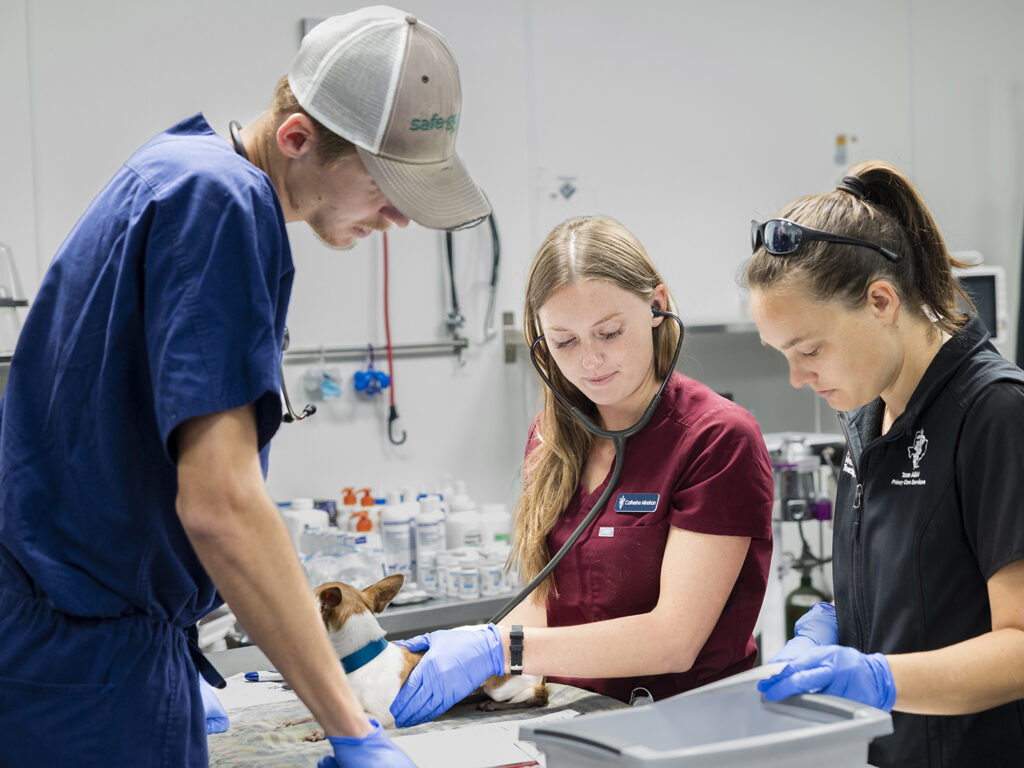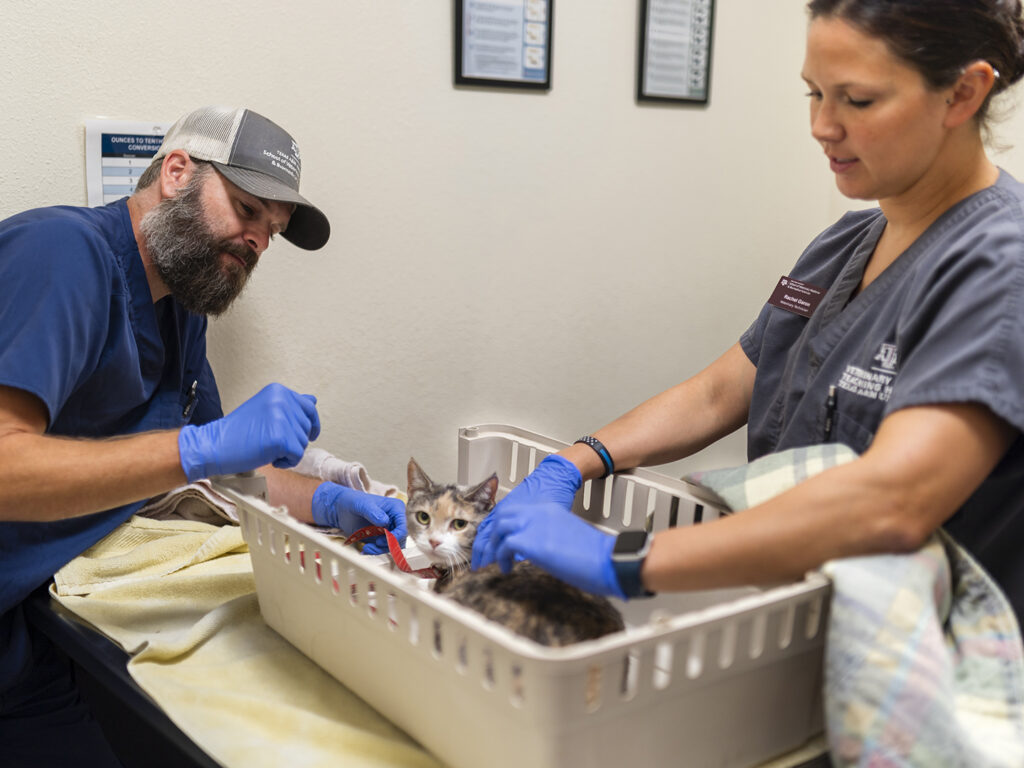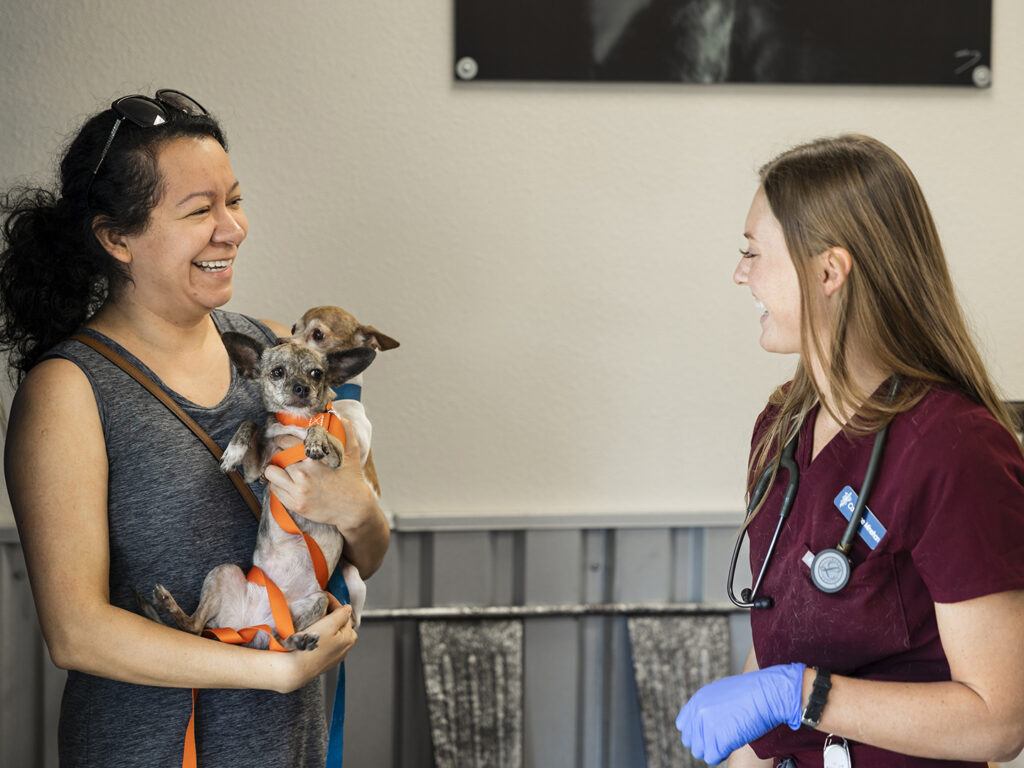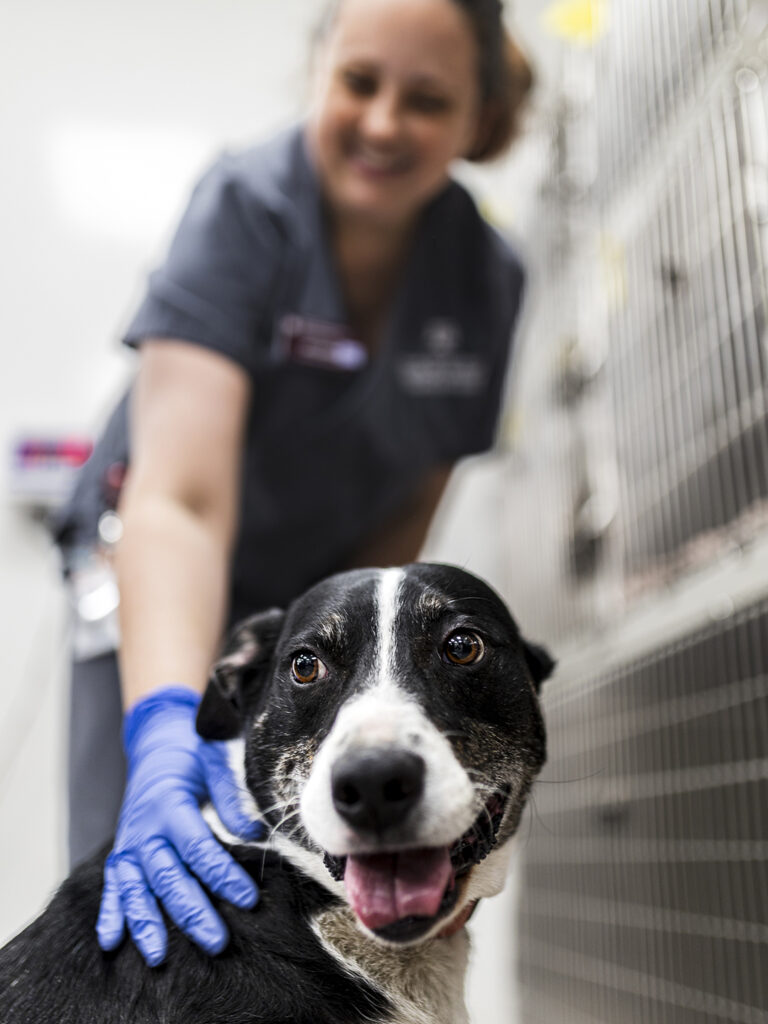Texas A&M Veterinary Hospital Provides Wellness Care To Animals In Underserved Areas
Story by Harley Nokes '24, VMBS Communications

Photo by Jason Nitsch ’14, Texas A&M University Division of Marketing and Communications
According to the U.S. Bureau of Labor Statistics, there were 18,810 veterinarians and veterinary technicians in Texas as of May 2022.
Of those, roughly 73% are located in Texas’s largest cities, including Austin, Dallas, Houston, and San Antonio, leaving those in rural communities without easy access to veterinary care and making it harder for pets to remain healthy and current on necessary vaccinations.
With the support of local organizations and donations, the Texas A&M College of Veterinary Medicine & Biomedical Sciences (VMBS) Primary Care team has arranged recurring community outreach clinics that provide thorough examinations and necessary vaccinations in rural areas. These events also provide veterinary students a chance to foster their leadership skills — a core Aggie value — while improving animal health in underserved populations.
Filling A Primary Care Gap With Rabies Vaccines
Three years ago, a veterinarian who had previously run a free rabies vaccination clinic in Caldwell — a rural community 30 miles southwest of Texas A&M University — was no longer able to provide the vaccinations. Because rabies vaccines must be administered by a veterinary professional, the Caldwell Rotary Club reached out to the VMBS for help that year in vaccinating their local pets.
Since then, an annual spring drive-through rabies vaccination clinic has been offered thanks to the continued coordination between the rotary club and the Veterinary Medical Teaching Hospital’s (VMTH) Primary Care Service.
“A mission of the Rotary Club of Caldwell is to ensure their local pets are vaccinated for rabies because they recognize that rabies is a deadly zoonotic disease, meaning it can affect both animals and humans,” explained Dr. James Bilof, a VMBS clinical assistant professor and one of the event’s organizers. “There is also no cure for pets who contract rabies, so it is important to keep our companion animals vaccinated.”

Photo by Jason Nitsch ’14, Texas A&M University Division of Marketing and Communications
While the VMBS provided veterinarians, technicians, and supplies such as syringes and rabies tags, industry veterinarians donated vaccines, showing how the veterinary community can come together to fill healthcare gaps.
With only three to four hours in an afternoon, veterinary students and professionals are tasked with providing client education, physical examinations, and vaccinations for dogs and cats. This allows students a chance to display their leadership abilities as they practice their veterinary skills and communication with clients.
“Veterinary students talk with owners to gather pet medical histories, perform physical exams, and then administer vaccinations, all while owners watch from their car,” Bilof said. “We have had a great turnout in the past three years, each year vaccinating at least 150 pets who are part of a rural community where access to veterinary care is not as prevalent as it is in Bryan-College Station.”
Receiving a required vaccination at no cost can be a relief to owners since this vaccine not only protects their pets from disease but their community as well.
“There is a significant relationship between the health of the people in a community and the health of their pets; veterinarians are important in maintaining this relationship,” Bilof said. “This outreach event shows the students who participated how important veterinarians are as leaders in their community. Engaging with and supporting local groups is one of the valuable roles they can play.”
Serving The Elderly By Caring For Their Pets
There are many health benefits for the elderly who own pets, including emotional support, companionship, and increased opportunities for fitness. Yet for some, it can be challenging when the time comes to transport their pet to the vet.
With help from Bastrop County Cares, a local nonprofit in Bastrop County, and a grant from PetCo Love, the VMTH Primary Care team visits with elderly pet owners outside of Austin to provide routine, and sometimes life-saving, veterinary care using a local shelter’s facilities.

Photo by Jason Nitsch ’14, Texas A&M University Division of Marketing and Communications
“We know that some people, particularly the elderly in rural communities, have a hard time accessing veterinary care, so we visit between 20-28 clients monthly to do what we can because our role is to support the bond between people and their pets, no matter their socioeconomic status,” said Dr. Lori Teller, a VMBS clinical professor and the event’s founder. “They can have up to three animals checked during one appointment, and we will provide wellness checks and vaccinations; testing for heartworms in dogs or feline leukemia and immunodeficiency virus in cats; deworming for potential parasites; starting heartworm prevention and flea and tick control; or checking a puppy for parvovirus if they come in with diarrhea.”
There is no limit to what a cat or dog can experience healthwise, which is why the veterinary team does their best to treat all concerns during the visit.
“Almost all of them have something, whether it is arthritis, a skin condition, ear infection, eye problem, or another concern,” Teller said. “We had a pet with pancreatitis, and we had another with an early kidney disease. We will manage all that we can manage.”
While pets are treated during an appointment slot that their owners signed up for, the care doesn’t end when the clinic is done for the day. In fact, the veterinary team ensures that both elderly owners and their pets are cared for long-term by connecting owners with outside resources.
“If there is a severe concern like heart failure, we’re not going to be able to manage that when we don’t have access to more advanced tools; if needed, we can arrange for them to be seen at A&M for additional evaluation and possible specialty care,” Teller explained. “In between our monthly visits, we can also use telemedicine to follow up and make sure the client is not having any problems or the patient’s not getting worse.
“If we identify that an owner has additional issues not related to veterinary care, maybe they have food insecurity or an issue in their house or apartment, we can let Bastrop County Cares know and then they can use their local resources to help meet the other needs those pet owners may have,” Teller continued. “This is a prime example of ‘it takes a village,’ and it’s not only the Bastrop village or the A&M village, but it’s the whole broader veterinary village helping pet owners.”

Photo by Jason Nitsch ’14, Texas A&M University Division of Marketing and Communications
In the process of caring for the elderly by addressing their pet’s needs, Primary Care students are given the opportunity to expand their leadership skills outside of the classroom and teaching hospital.
“The students are the doctors, so to speak, because they are the ones doing most of the communication, diagnostics, and treatment planning,” Teller said. “We step in when we need to step in, but, otherwise, the students are running the show. They will run their diagnostics and treatment plan by us and if it sounds right on the spot, then they go with it. If we need to help tweak the plan, then we tweak it.”
The Impact Of Veterinary Clinics
While rural communities across the state are without easy access to veterinary care, the VMTH Primary Care team has alleviated that concern for local communities around Bryan-College Station. Their efforts to serve the veterinary population outside the university has ensured that pets are cared for and can live happy, healthy lives with their families.
“Thank you so much for helping me,” said a Bastrop County client who owns Lulu, a 3-year-old chihuahua who serves as an emotional support animal for her low-income owner. “You took a big burden off of my life, giving my dog healthcare I couldn’t afford.”
These outreach events have also shown rising veterinary professionals the impact their work can have on pet owners.
“Events like this mean the world to me,” said a VMBS student who participated in the Caldwell clinic. “For so many individuals, outreach events are their only opportunity to provide for their pets. I have been the person standing in line at similar events with my mom and pets, unable to afford veterinary care. Being able to participate and help others like I was previously helped as a child really touches my heart.”
###
Note: This story originally appeared in the Fall 2023 issue of VMBS Today.
For more information about the Texas A&M College of Veterinary Medicine & Biomedical Sciences, please visit our website at vetmed.tamu.edu or join us on Facebook, Instagram, and Twitter.
Contact Information: Jennifer Gauntt, Director of VMBS Communications, Texas A&M College of Veterinary Medicine & Biomedical Sciences; jgauntt@cvm.tamu.edu; 979-862-4216


